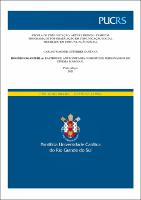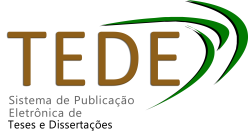| Share record |


|
Please use this identifier to cite or link to this item:
https://tede2.pucrs.br/tede2/handle/tede/9677Full metadata record
| DC Field | Value | Language |
|---|---|---|
| dc.creator | Santana, Carlos Wagner Guterres | - |
| dc.creator.Lattes | http://lattes.cnpq.br/8633670425986821 | por |
| dc.contributor.advisor1 | Gutfreind, Cristiane Freitas | - |
| dc.date.accessioned | 2021-06-01T17:54:20Z | - |
| dc.date.issued | 2021-03-19 | - |
| dc.identifier.uri | http://tede2.pucrs.br/tede2/handle/tede/9677 | - |
| dc.description.resumo | O presente trabalho pretende investigar os rastros de antropofagia no rosto de personagens do Cinema Marginal demonstrado pelos longas-metragens do cineasta brasileiro Rogério Sganzerla: Sem essa, Aranha (1970) e Copacabana mon amour (1970), que foram produzidos em meio a um cenário turbulento, e em plena Ditadura Militar, com destaque para a neo antropofagia e o Cinema Novo que, dentre outros movimentos engajados, dialogaram com a cinematografia do cineasta. O problema da pesquisa é fomentado pela discussão acerca da presença de uma antropofagia (Andrade, 1990; 2017) no rosto (Deleuze, 2005; 2010; 2018) pertencente às obras, capazes de influenciar a produção de sentidos dos filmes. Daí a suspeita do surgimento de uma antropofagia que se desvela em pequenos detalhes de atos em que os personagens devoram simbolicamente o opressor para aumentarem suas potencialidades, em contraponto ao Cinema Novo. Tal questão parte do pressuposto de que os personagens se alimentam do inimigo e regurgitam contra ele em planos da face e em rastros deixados nas imagens que deslocam o analista para uma posição mais ativa diante dos filmes. Além dos teóricos já citados, trabalhamos também com as ideias de Pierre Clastres (1995), Beatriz Azevedo (2018), Antônio Candido (1964, 1976, 2006) e Guiomar Ramos (2008) para uma compreensão da antropofagia que perpassa diferentes maneiras de inserção do tema ao longo do tempo, com ênfase no cinema antropofágico, além de Fernão Ramos (1987), Jairo Ferreira (2000, 2012), Jean-Claude Bernadet (1991, 2004), Eugênio Puppo (2012) e Ismail Xavier (2012) assim como depoimentos dos próprios diretores, que nos ajudam a desvendar a complexidade do Cinema Marginal. Trago também, além de Gilles Deleuze, Roberto Machado (2009) e Pedro Guimarães (2016a; 2016b), pois se trata aqui de uma antropofagia incluída no rosto dos personagens, assim busquei desenvolver os conceitos de imagem afecção, rosto e rostidade para amparar a categoria de análise da pesquisa. A metodologia, por sua vez, foi embasada pelos estudos de Walter Benjamin (1994) à luz do conceito de rastros, sendo que se bem buscados e organizados podem compor um mosaico capaz de reconfigurar imposições e injustiças históricas | por |
| dc.description.abstract | The presente work intends to investigate the traces of anthropophagy on the faces of characters from the Marginal Cinema demonstrated by the feature films of the Brazilian filmmaker Rogério Sganzerla: Sem essa, Aranha (1970) and Cobacabana mon amour (1970), that were produced in the midst of a turbulent scenario, aind in the middle of the Military Dictatorship, with emphasis on the neo-antropophagy and the Cinema Novo which, among other engaged movements, dialogued with the cinematography of the filmmaker. The research problem is fueled by the discussion about the presence of na antropophagy (Andrade, 1990; 2017) in the face (Deleuze, 2005; 2010; 2018) belonging ti the works, capable of influencing the production of meanings in the film. Hence the suspicion of the emergence of na anthropophagy thatreveals itself in small details of acts in wich the characters symbolically devour the opressor to increase their potential, in contrast to Cinema Novo. This question starts from the assumption that the characters feed on the enemy and regirgitate against him in planes of the face and in tracks left in the images that move the analyst to a more active and thinking position in front of the films. In addition to the theorists already mentioned, we will also work with the ideas of Pierre Clastres (1995), Beatriz Azevedo (2018), Antônio Candido (1964, 1976, 2006) e Guiomar Ramos (2008) for na undestanding of anthropophagy that permeates diferente ways of inserting the theme over time, with na emphasis on anthropophagic cinema, in addition to Fernão Ramos (1987), Jairo Ferreira (2000), Jean Claude Bernadet (1991, 2004), Eugênio Puppo (2012) e Ismail Xavier (2012) as well as testimonies from the direstors themselves, who help us to unravel the com complexity of Cinema Marginal. I also bring, in addition to Gilles Deleuze, Roberto Machado (2009) e Pedro Guimarães (2016a; 2016b), because this is an anthropophagy included in the characters‘ faces, so I tried to develop the concepts of affection-image, face and face to support the research analysis category. The methodology, in turn, will be based on studies of Walter Benjamin (1994) in the light of the concepto of trails, and if well sought and organized, they can composse a mosaic capable of reconfiguring historical impositions na injustices | eng |
| dc.description.provenance | Submitted by PPG Comunicação Social ([email protected]) on 2021-05-04T16:52:23Z No. of bitstreams: 1 DISSERTAÇÃO_CARLOS_SANTANA.pdf: 2727827 bytes, checksum: ca0afdf2865869a078fecb54a475d0e1 (MD5) | eng |
| dc.description.provenance | Rejected by Sheila Dias ([email protected]), reason: Devolvido devido o trabalho ter vindo com divergência entre títulos. Na capa institucional e ficha catalográfica consta "rastros de...", e na folha de rosto e na folha da banca não consta. on 2021-05-18T16:06:06Z (GMT) | eng |
| dc.description.provenance | Submitted by PPG Comunicação Social ([email protected]) on 2021-05-26T16:23:28Z No. of bitstreams: 1 Carlos_Wagner_Guterres_Santana_DIS.pdf: 2727932 bytes, checksum: 6c3166e1038d4514542a1a2db142946a (MD5) | eng |
| dc.description.provenance | Approved for entry into archive by Sarajane Pan ([email protected]) on 2021-06-01T17:45:31Z (GMT) No. of bitstreams: 1 Carlos_Wagner_Guterres_Santana_DIS.pdf: 2727932 bytes, checksum: 6c3166e1038d4514542a1a2db142946a (MD5) | eng |
| dc.description.provenance | Made available in DSpace on 2021-06-01T17:54:20Z (GMT). No. of bitstreams: 1 Carlos_Wagner_Guterres_Santana_DIS.pdf: 2727932 bytes, checksum: 6c3166e1038d4514542a1a2db142946a (MD5) Previous issue date: 2021-03-19 | eng |
| dc.description.sponsorship | Conselho Nacional de Pesquisa e Desenvolvimento Científico e Tecnológico - CNPq | por |
| dc.format | application/pdf | * |
| dc.thumbnail.url | http://tede2.pucrs.br:80/tede2/retrieve/181053/Carlos_Wagner_Guterres_Santana_DIS.pdf.jpg | * |
| dc.language | por | por |
| dc.publisher | Pontifícia Universidade Católica do Rio Grande do Sul | por |
| dc.publisher.department | Escola de Comunicação, Arte e Design | por |
| dc.publisher.country | Brasil | por |
| dc.publisher.initials | PUCRS | por |
| dc.publisher.program | Programa de Pós-Graduação em Comunicação Social | por |
| dc.rights | Acesso Aberto | por |
| dc.subject | Rogério Sganzerla | por |
| dc.subject | Cinema | por |
| dc.subject | Rastros | por |
| dc.subject | Antropofagia | por |
| dc.subject | Rosto | por |
| dc.subject | Rogério Sganzela | eng |
| dc.subject | Movie Theater | eng |
| dc.subject | Traces | eng |
| dc.subject | Anthropophagy | eng |
| dc.subject | Face | eng |
| dc.subject.cnpq | CIENCIAS SOCIAIS APLICADAS::COMUNICACAO | por |
| dc.title | Rogério Sganzerla : rastros de antropofagia no rosto de personagens do cinema marginal | por |
| dc.type | Dissertação | por |
| dc.restricao.situacao | Trabalho não apresenta restrição para publicação | por |
| Appears in Collections: | Programa de Pós-Graduação em Comunicação Social | |
Files in This Item:
| File | Description | Size | Format | |
|---|---|---|---|---|
| Carlos_Wagner_Guterres_Santana_DIS.pdf | CARLOS_WAGNER_GUTERRES_SANTANA_DIS | 2.66 MB | Adobe PDF |  Download/Open Preview |
Items in DSpace are protected by copyright, with all rights reserved, unless otherwise indicated.




